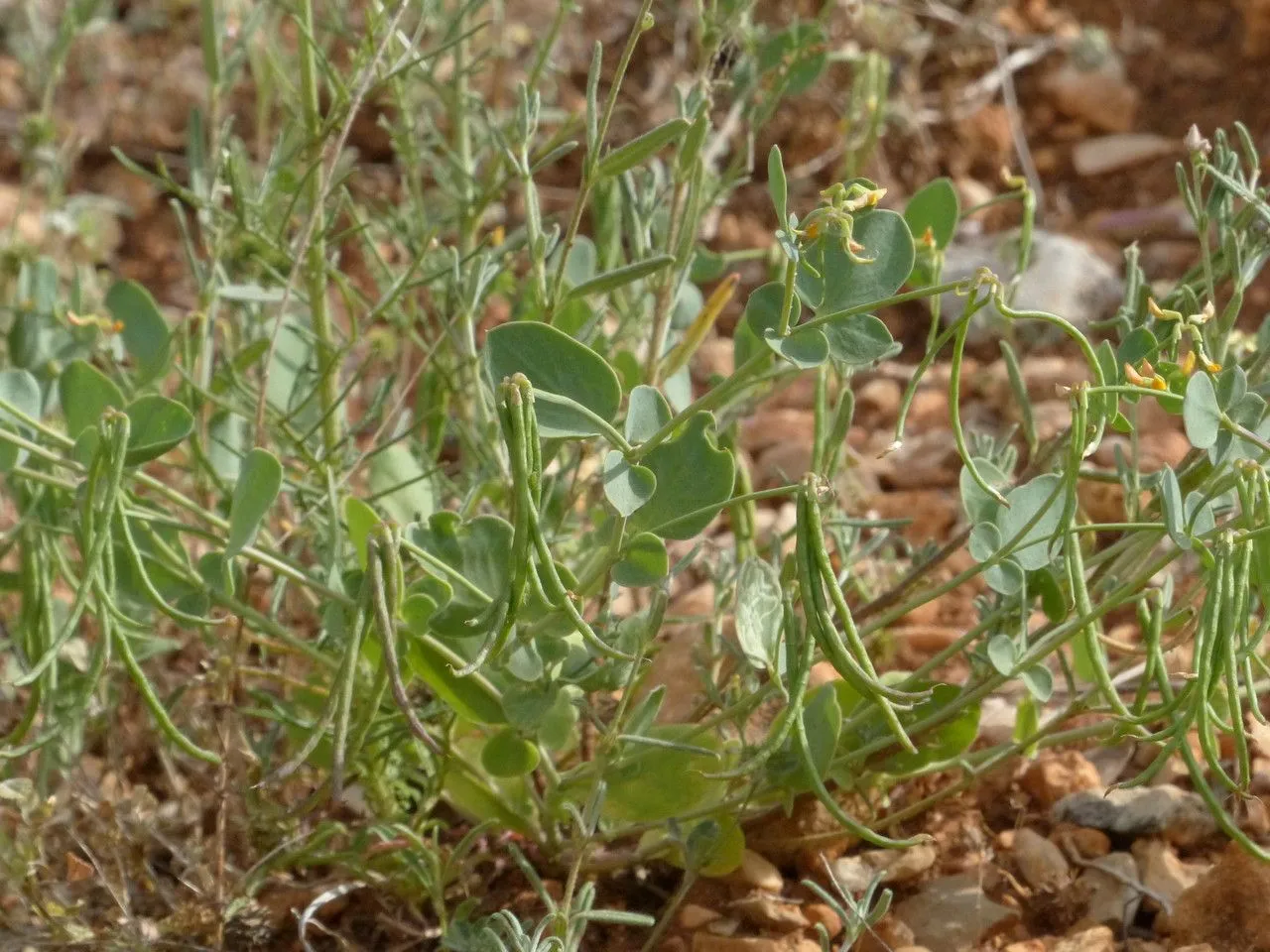
Author: (L.) W.D.J.Koch
Bibliography: Syn. Deut. Schweiz. Fl. 1: 188 (1837)
Year: 1837
Status: accepted
Rank: species
Genus: Coronilla
Vegetable: False
Observations: Medit. to Iran and Eritrea
Annual scorpion-vetch, scientifically known as Coronilla scorpioides, is a fascinating member of the Fabaceae family. First described by the botanist W.D.J. Koch in 1837, this plant has garnered attention for its distinctive appearance and adaptability.
Native to regions spanning from the Mediterranean to Iran and Eritrea, the annual scorpion-vetch thrives in a variety of climates and terrains. This geographic range indicates a robust adaptability, allowing it to flourish in diverse environmental conditions. This adaptability makes it an interesting subject for studies regarding plant survival and propagation in varying habitats.
The plant derives its common name from its unique seed pods, which curl in a manner reminiscent of a scorpion’s tail. This characteristic feature not only provides an easy identifier for the species but also highlights the intriguing morphological adaptations plants can develop.
Belonging to the Fabaceae family, which is known for its importance in agriculture and ecology, the annual scorpion-vetch plays its part in enriching soil fertility through nitrogen fixation. This mutualistic relationship with nitrogen-fixing bacteria converts atmospheric nitrogen into forms usable by the plant, thereby enhancing soil quality and benefiting surrounding vegetation.
In traditional settings, plants from this family have various uses, and while specific ethnobotanical uses of Coronilla scorpioides are not well-documented, its relatives are often utilized in soil conservation and as cover crops due to their ability to improve soil health.
For botanists and horticulturists, the annual scorpion-vetch represents a plant of interest not just for its resilience and ecological contributions, but also for its aesthetic appeal. Its flowers, typically yellow and blooming abundantly, contribute a splash of color to the landscapes it inhabits, adding to the biodiversity and beauty of the regions.
In summary, Coronilla scorpioides, or the annual scorpion-vetch, is more than just a plant; it is a resilient and adaptable species that enhances our understanding of plant biology and ecology. From its unique morphology to its ecological benefits, this species has much to offer both scientifically and aesthetically.
Eng: annual scorpion-vetch, yellow crownvetch, yellow crown-vetch, scorpion crown-vetch
Dan: enårig perlebælg
Deu: skorpions-kronwicke
Fra: coronille faux-scorpion, coronille queue-de-scorpion
Cat: herba de l´escorpí
Swe: maskkronill
Cym: ffacbys sgorpion unflwydd, ffacbysen sgorpion unflwydd
En: Annual Scorpion-vetch, Yellow crownvetch, Yellow crown-vetch, Scorpion crown-vetch
Ar: خويتمه (خُوَيْتمه)
Ca: Herba de l´escorpí
Da: Enårig perlebælg
Fr: Coronille faux-scorpion, Coronille queue-de-scorpion
De: Skorpions-Kronwicke
Sv: Maskkronill
Cy: Ffacbys Sgorpion Unflwydd, Ffacbysen Sgorpion Unflwydd
© copyright of the Board of Trustees of the Royal Botanic Gardens, Kew.
© copyright of the Board of Trustees of the Royal Botanic Gardens, Kew.
© copyright of the Board of Trustees of the Royal Botanic Gardens, Kew.
Taken May 15, 2022 by Diego Alex (cc-by-sa)
Taken May 22, 2021 by Maria Bañeres (cc-by-sa)
Taken May 18, 2021 by Bruno Moreira (cc-by-sa)
Taken May 16, 2016 by Martin Bishop (cc-by-sa)
Taken May 23, 2021 by pitorac dorina (cc-by-sa)
Taken Jul 11, 2022 by Todd Allen (cc-by-sa)
Taken Jun 6, 2020 by Eduardo Cruz (cc-by-sa)
Taken Apr 25, 2019 by Emma Leudiere (cc-by-sa)
Taken May 16, 2016 by Martin Bishop (cc-by-sa)
Taken Feb 19, 2022 by nabi karabulutoglu (cc-by-sa)
Taken May 9, 2020 by claude sarrat (cc-by-sa)
Taken May 16, 2016 by Martin Bishop (cc-by-sa)
Taken May 23, 2021 by pitorac dorina (cc-by-sa)
Taken Feb 19, 2022 by nabi karabulutoglu (cc-by-sa)
Taken Feb 19, 2022 by nabi karabulutoglu (cc-by-sa)
Taken Jun 4, 2013 by Daniel Barthelemy (cc-by-nc)
Taken Jun 4, 2013 by Daniel Barthelemy (cc-by-nc)
Taken Jun 4, 2013 by Daniel Barthelemy (cc-by-nc)
Taken Jun 4, 2013 by Daniel Barthelemy (cc-by-nc)
Taken May 15, 2020 by Viviane Rezzoug (cc-by-sa)
Taken Jun 4, 2013 by Daniel Barthelemy (cc-by-nc)
Taken Jun 4, 2013 by Daniel Barthelemy (cc-by-nc)
Taken Jun 4, 2013 by Daniel Barthelemy (cc-by-nc)
Taken May 15, 2020 by Viviane Rezzoug (cc-by-sa)
Taken May 9, 2020 by claude sarrat (cc-by-sa)
Growth habit: Forb/herb
Family: Myrtaceae Author: (F.Muell.) K.D.Hill & L.A.S.Johnson Bibliography: Telopea 6: 402 (1995) Year: 1995 Status:…
Family: Rubiaceae Author: Pierre ex A.Froehner Bibliography: Notizbl. Bot. Gart. Berlin-Dahlem 1: 237 (1897) Year:…
Family: Sapindaceae Author: Koidz. Bibliography: J. Coll. Sci. Imp. Univ. Tokyo 32(1): 38 (1911) Year:…
Family: Asteraceae Author: A.Gray Bibliography: Pacif. Railr. Rep.: 107 (1857) Year: 1857 Status: accepted Rank:…
Family: Fabaceae Author: Medik. Bibliography: Vorles. Churpfälz. Phys.-Ökon. Ges. 2: 398 (1787) Year: 1787 Status:…
Family: Aspleniaceae Author: (Cav.) Alston Bibliography: Bull. Misc. Inform. Kew 1932: 309 (1932) Year: 1932…